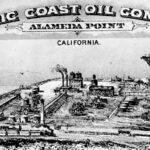Draining jet fuel from Navy planes, known as defueling, was a routine step before doing maintenance work on the planes. This defueling process at Alameda Point inadvertently contaminated groundwater at one location across the street from the Pottery Barn Outlet on West Oriskany Avenue. During February, the Navy’s cleanup contractor conducted a form of industrial-scale in-ground chemotherapy known as oxidation.
The Secret is Sodium Percarbonate
 [1]
[1]The injected chemical compound breaks apart the fuel molecules, turning them into harmless carbon dioxide, water, and oxygen. The main ingredient in this oxidation process is sodium percarbonate, the same active ingredient in OxyClean™ laundry whitener and stain remover, albeit with a different objective.
Various formulas for chemical oxidation of petroleum products in groundwater have been in use for decades. Coincidentally, one of those formulas relied upon another chemical found in household laundry cleaning products – hydrogen peroxide, which is the main ingredient in chlorine-free bleach.
There is yet another chemistry connection between laundry cleaning and jet fuel cleanup. If sodium percarbonate, the active ingredient being used by the Navy for jet-fuel cleanup, is dissolved in water, it turns into sodium carbonate, the main ingredient in Arm and Hammer’s washing soda, and hydrogen peroxide.
The product being used by the Navy today, called RegenOx™ [2], eliminates many of the shortcomings of other chemical oxidation technologies that can leave behind residual chemicals that interfere with natural bacterial activity that breaks down petroleum.
“When developing the product, a main objective was to employ an oxidant within the formulation that would not negatively interfere with bioremediation processes that would occur after the oxidation was complete,” states the manufacturer Regenesis [3]. “Between the use of simple sodium percarbonate and the design of the Regenesis two-part catalyzed activator complex technology, we have achieved this objective.”
Aircraft defueling stations were located next to Building 530 at the corner of West Oriskany Avenue and Skyhawk Street. They were connected via underground piping to two nearby above-ground storage tanks, one for storing jet fuel and one for storing a rinsing oil used to rinse out the fuel system.
After initial defueling on the runway, the aircraft was brought to this area to defuel and rinse the fuel system with the rinsing oil. The defueling area was used to remove fuel and inert aircraft fuel systems for aircraft maintenance from 1961 to 1995. Defueling operations ceased in 1995, and the defueling facility was decommissioned in the late 1990s.
 [4]
[4]Vapor Extraction Left Behind Contaminated Groundwater
Between 2002 and 2004, residual jet fuel was removed from soil at this site using a vapor extraction system [5] that vacuumed jet fuel into a carbon filter. But contamination still remained in the groundwater when the vacuum process had maxed out its effectiveness. Additional treatment of the groundwater with a different method was delayed until recently because the jet fuel was not migrating or posing a health risk, and because the City of Alameda had no immediate plans to redevelop the site.
The 26,000-square-foot area received 133 injections of the oxidizing compound. The injections were performed by first cutting holes in the concrete and then forcing a steel pipe 20 feet into the ground using a specialized piece of equipment. The two-part solution was mixed in a tank at the site using water from a fire hydrant and then injected via a hose connected to a hose bib on the pipe.
The second round of injections will be determined after comparing the results of groundwater monitoring data, which will be conducted for the next three years.
Future use of the site will be commercial and light industrial.
Contributing writer Richard Bangert posts stories and photos about environmental issues on his blog Alameda Point Environmental Report, https://alamedapointenviro.com/ [6].



